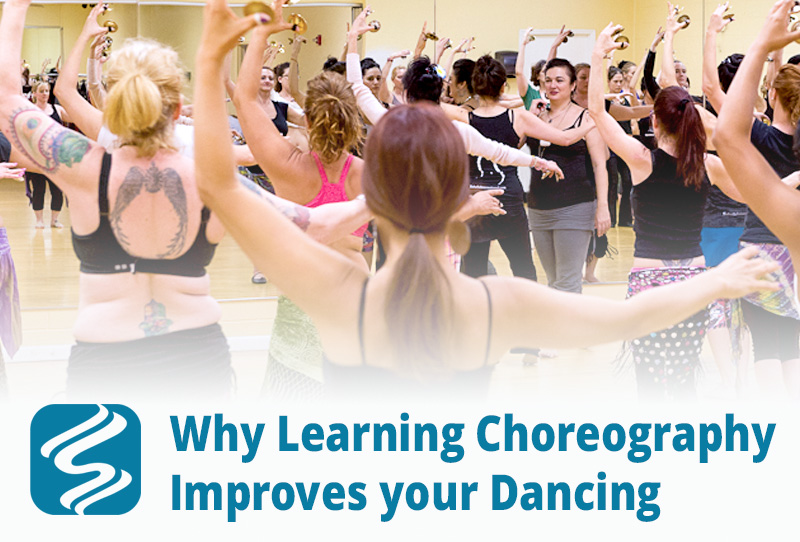But many dancers ask why they need to learn choreography at all. They wonder why they need to learn a dance that they might never perform. Or, they lament that they don’t even like a certain choreography. Why should they have to learn a dance they don’t even like?
Others wonder why they can’t just make up their own choreographies or just stick with improvisation because it’s more “expressive” or “personal.”
But learning the work of artists, particularly those who are masters in their field, is essential to being a well-rounded and well-studied practitioner of that art, whether it’s dance, music, theater, or even martial arts. This is even more true when you’re studying the method of a particular school or dancer… like in the Suhaila Salimpour Institute of Online Education.
It’s a Common Skill in Classical Performing Arts
First, it’s important that we understand that learning set works—whether they be martial arts moves, musical compositions, dressage patterns, or dance choreographies—is a common learning requirement of classical performance and movement forms around the world.
Classical Indian dance schools require students to learn long and complex dance pieces, which they perform in ceremonial recitals to demonstrate that they have reached a certain level of proficiency and accomplishment.
Music students of many cultural traditions also perform works composed by other people in regular performance recitals. Rarely do they perform works that they’ve composed on their own, at least not until they have been studying for quite a long time or until they are studying at a conservatory or music school.
And students of martial arts must demonstrate a sequence of movements, which are evaluated by the sensei or master of the school (or dojo), so that they can earn the next color belt and move into the next level of training.
Figure skaters, ice dancers, and even dressage riders also learn set sequences of movements that they must memorize and perform in front of judges. The judges give scores and grades that determine whether the student is ready to move up into the next, more difficult, skill level. If the student passes, then they can begin learning more complex and challenging movements, sequences, and commands.
So, why do so many disciplines require students to learn other people’s work?
1. Apply Your Technique
Learning choreographies gives you a chance to apply the technique that you’ve been learning in your classes in a structured and methodical way. And we at the Salimpour School love structure, because it gives you a strong foundation on which to learn and succeed and dance with confidence. So, learn that new choreography and put your skills to work!
2. Gain Professional Skills
In most academic settings, dancers are required to learn short phrases in their studio classes as well as longer works created by their colleagues and instructors. The reason is that professional dancers are expected to be able to learn choreography quickly and with ease.
Now, you might think that you “aren’t good at learning choreography,” while other dancers pick up choreography and phrases with ease. But if you find learning choreographies or combinations challenging, there’s good news: the more you do it, the better you’ll get at it. There’s a reason that most studio dance classes include a combination at the end of class; that’s so that you can build your movement memorization skills quickly and apply that knowledge when learning longer works.
3. Put Music into Movement
When you learn a specific choreography, part of your work is to understand the music to which you’re dancing. The music will tell you when to transition into the next phrase, and even which phrase to do next. These are essential skills in musicality: understanding how to express music through motion.
So when you learn a piece, you’re also learning how to listen to music. Sometimes dancers make the mistake of trying to learn the dance without really knowing the music… and it’s usually so much harder! The music has all the answers to the dance.
Suhaila teaches a system of listening to and breaking down music using tallies, which will help you understand the structure of any music that you’re dancing to. You can learn more about it on our Online Class website.
4. Learn the Tools to Make Your Own
And building on the last point, when you learn choreography, you’re learning the tools and building blocks for creating your own work. And we don’t just mean knowing how to string movements together to a song. Creating choreography involves storytelling, emotional intent, projection, and how you move on the stage, which are all elements that you put into practice when learning someone else’s choreography.
Even the Level 2 Finger Cymbal Drum Solo—which Suhaila says is “just a drill”—contains choreographic elements, such as an opening promenade pattern, a twist-filled wind-up, and a spin at the end.
We don’t mean that you’ll just use elements of choreographies that you’ve learned and dance them as your own (although we do love a good homage), but you’ll have a keen sense of how to thread movements together, how to create interesting and effective transitions, and you’ll have a trained physical response to music from which to draw.
5. Lay Strong Foundations for Improvisation
All the choreographies you learn as a student of the Salimpour School—most by Suhaila herself—are also tools for you to learn how to be a well-rounded and skilled belly dancer. Each one is an important element and step in your training. You’ll learn classic opening pieces, fun folkloric stylizations, and challenging contemporary pieces. And when you begin improvising either to recorded or live music, you can call upon the movement and listening skills that you didn’t even know that you’ve been developing when learning Salimpour choreographies. Elements like promenading during an entrance or spinning at the end of a song before the final pose will begin to be part of your natural response to the songs to which you’re dancing. All because you learned set dances.
And, at its heart, belly dance is an improvisational form. The heart and soul of this dance form is a mastery of improvisation to a live band…. And that improvisation should look like choreography in its intention, but also be a moment-to-moment, educated and knowledgeable response to the music.
But if you have not grown up listening to Arabic and other MENATH (Middle Eastern, North African, Turkish, Hellenic) music, if you did not spend evenings dancing in the home with your aunties and cousins, then knowing how to move to the music, understanding the nuances, and having movement vocabulary from which to draw upon in your own body is going to be a challenge.
Because many people come to belly dance as adults, learning those embodied reactions to music, sentiment, and lyrics comes far less naturally, especially because most dancers who study this dance form as a serious hobby are not from MENATH cultures.
6. Be a Part of a Living Legacy
When you learn the works of master artists, you are embodying their legacy, giving it new life, and sharing it with new audiences and eyes.
And you wouldn’t train with, say, the Martha Graham School, Alvin Ailey American Dance Theater, or the Chitresh Das Institute without learning the major works of these dancers and choreographers. So it’s only expected that if you’re studying at the Salimpour School of Dance you will learn works by Suhaila Salimpour, her mother Jamila Salimpour, and esteemed dancers in the school.
Learning these works helps you embody the legacy of these dancers and traditions, and by doing them, you will have a deeper appreciation for them.
7. Bonus: A Script for Your Creativity
Another way to look at choreography is that it’s like a script for a play or film. The words are set by the writers, and the actors’ job is to give life, emotion, and expression to those words. The actors need to make those words real and believable.
And… Actors generally don’t complain that they don’t like the words presented to them. They don’t ask why they can’t just make up their own dialogue. No, they learn the script and make those words their own, giving them life, expression, and character. So, learning choreographies is, in a way, your job when studying at the Salimpour School. As you gain more experience, learn more about your body, refining and build your technical skills, the more you can make these choreographies your own, imbuing them with your personality, spirit, and interpretation… just as an actor would on the stage.
So the next time you’re faced with learning a new choreography, remember that you’re taking part in a time-honored tradition that keeps legacy alive and will help you dance with confidence, skill, and ease.
Check out dancers in Salimpour Collectives in Florida and California who perform choreographies from the Suhaila Salimpour Institute of Online Education… and see how they all add their own character and personalities!
The original blog was published in the Salimpour School blog on 25 Feb 2021

